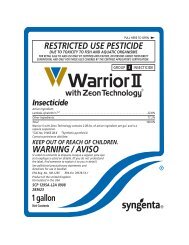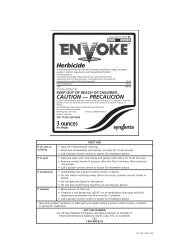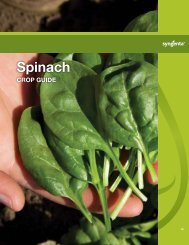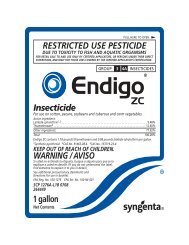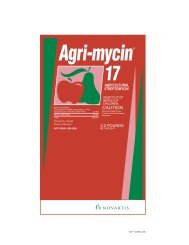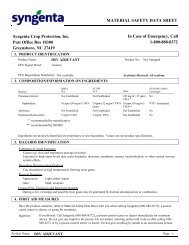Sweet Corn
Sweet Corn - Syngenta
Sweet Corn - Syngenta
You also want an ePaper? Increase the reach of your titles
YUMPU automatically turns print PDFs into web optimized ePapers that Google loves.
<strong>Sweet</strong> corn endosperm classificationThe endosperm is the primary food storage for corn seedand makes up most of the physical bulk of the seed. Thetype of endosperm in a sweet corn variety is importantbecause of the effect on planting seed and eating quality.The following chart contains general information. Eachvariety must be judged on its own merits.Sugary (su) typesThese are the original sweet corns used by your grandparents. Todaythe su varieties are known for superior seed quality, but generally lackappeal to the fresh market consumer. This is largely due to the lowersugar levels and rapid conversion of sugar to starch severely limitingthe shelf life of the su varieties.pros• Exceptional seed vigor and germination• Fast establishment• <strong>Corn</strong> flavor• Less ear damage during harvest• Usually reliable seed productionpros• Exceptional tenderness• Extra sweetness• Extended shelf life(1-2 days better than se)• Extended field holding ability (1-2 days)• Great for local and roadside markets• Same isolation as sugary (su) andse varietiescons• Lowest sugar at harvest• Lack of field holding• Fastest sugar loss after harvestTriple<strong>Sweet</strong> and Triple<strong>Sweet</strong> PlusTriple<strong>Sweet</strong> and Triple<strong>Sweet</strong> Plus varieties offer a new class of sweetcorn, containing 75 percent sugary enhanced (se) kernels and 25percent supersweet kernels and 56 percent sugary enhanced (se)kernels and 44 percent supersweet kernels respectively. Triple <strong>Sweet</strong>and Triple <strong>Sweet</strong> Plus varieties combine the exceptional tendernessand flavor of se varieties with extra sweetness, extended shelf-lifeand field holding ability; and deliver more consistent, longer-lastingsweetness, even under drought stress, making them ideal for roadsidemarkets and local shipping.cons• Can be damaged at harvest likese varieties• Shelf life is not as long assh2 varietiesGuide to growing sweet cornThe following tips and guidelines are designed to help you maximizethe emergence of your Syngenta sweet corn seed.Soil moisture/preparationAvoid moisture extremes such as heavy, poorly drained soils orextremely light, unevenly moist soils. Seed beds must be wellpreparedto maintain sufficient moisture at shallow planting depths.• <strong>Sweet</strong> corn seeds are most sensitive to cold, wet conditions duringthe first 24 hours after planting• Avoid planting right before a cold front and heavy rain• Provide adequate, even moistureType Kernel Composition % SugarSugary su 9–16SugarEnhancedTriple<strong>Sweet</strong>Triple<strong>Sweet</strong> Pluspros• <strong>Sweet</strong>ness• Tenderness• Flavor• Disease resistance• Same isolation as sugary (su) varietiesprosHeterozygous 50% seHomozygous 100% se75% se25% supersweet44% supersweet56% seSugary Enhanced (se) typesA relatively new type or class, the se varieties have been in use sincethe 1970s with the first scientific description in 1978. Se varieties havedramatically increased in popularity because of their sweetness, textureand consumer appeal. Se varieties also have an increased shelflife compared to the su types.• Very sweet• Increased sugar holding/shelf life in thefield and during post-harvest marketing• Increased harvest flexibility• Less sugar variation between environments• Less damage during harvest• Good shipping abilityconsSupersweet or Shrunken (sh2)• Less shelf life and fieldholding than sh2 varieties• <strong>Sweet</strong>ness performancevaries with climate• In general, less seed vigor andgerm than sugary (su) varietiescons14–2220–28Supersweet sh2 28–44This class or genetic type was first described in the 1950s with thefirst successful hybrid introduced in the late 1970s. Popularity of sh2varieties continues to increase due to the high sugar content and fieldholding ability. The increased shelf life improves distribution ease andallows for a high-quality product in the fresh market distribution chain.• Sh2 varieties have a reputation ofbeing “crunchy” with less corn flavorand lower seed quality• More difficult to plant and obtain stand• Physically weaker seed and issubject to breakage• Need isolation from all other typesSoil temperaturesWarm soil temperature is recommended. Planting sweet corn seedtoo early, in too cool soil is probably the single most commonreason for a poor stand. <strong>Sweet</strong> corn varieties exhibit the best emergencewhen soils can maintain 60 F to 65 F. At 50 F seed will imbibewater but won’t grow.Planting depthPlant the seed no deeper than needed to reach moisture and notmore than 1.5 inches. Best emergence occurs when seed is notplanted too deeply. Uniformity of planting depth is important. Checkfor proper seed placement.Grower guide forAttribute sweet cornAttribute ® and Attribute II sweet corn varieties from Syngenta are aviable crop strategy for sweet corn growers throughout the country.Commercially grown since 1998, Attribute sweet corn seeds providea high level of above-ground protection against targeted peststhroughout the growing season. With Attribute sweet corn, growershave another option for harvesting outstanding yields of high-qualitysweet corn that meets market needs. If properly managed, Attributesweet corn can be a valuable addition to your crop managementstrategy for many years to come.Attribute trait stack performanceSince the introduction of the Attribute trait stack, numerous field trialshave been conducted by Syngenta throughout the U.S. Results fromthese trials indicate that Attribute sweet corn showed significantly lessdamage from targeted pests, while non-Attribute protected plantssuffered extensive damage from European corn borers and cornearworms. As a result, Attribute hybrids are an effective strategy forcontrolling European corn borer and corn earworm insect populations.Results to date indicate that under most conditions, more than 95percent of Attribute plants remain virtually free of European cornborer and corn earworm damage throughout the growing season;however, the expected level of protection can vary depending uponenvironmental factors and seed purity. European corn borers andcorn earworms can migrate from non-Bt plant to Bt plants, so somecorn borer and earworm larvae may be seen on Attribute sweet cornthat borders non-Bt fields. Because European corn borers and cornearworms cannot distinguish between Bt and non-Bt hybrids, eggmasses may be found on Attribute plants. But once small larvaebegin feeding on them, they quickly ingest the Bt protein and die. Tooptimize yields and ear quality, scout fields for pest outbreaks, andwhere necessary, apply chemical insecticides to prevent economic loss.Insect pests which are not controlled by this Bt protein include: cornrootworms, cutworms, common stalk borers, silk fly larvae, sap beetles,aphids and flea beetles. Attribute II, which combines Vip3A with the Btprotein found in Attribute, does provide control of several additionalpests including black cutworm and Western bean cutworm. However,where possible, consult your area pest management specialists or localextension agents for additional insight on pest outbreaks in your areaand suggested control options.IPM strategiesAttribute sweet corn is an important IPM tool that can reduce the needfor chemical pest control. Unlike broad-spectrum insecticides, whichcan destroy beneficial insect populations, Attribute sweet corn is notharmful to ladybird beetles, lacewings and other beneficial insects.While Attribute sweet corn can be a powerful IPM tool to controlEuropean corn borers and corn earworms, it is not an end-all solutionfor pest control. Years of IPM experience have shown that usingmultiple-control tactics over time is the best strategy for preservingecological diversity. Under high corn-earworm pressure found inthe southern half of the U.S. and with late-season planting, somepest damage can occur in Attribute sweet corn fields. If the marketrequires close to zero insect damage, some chemical control methodsmight be necessary. The number of applications and timing of theseapplications depend on the corn earworm pressure and environmentalconditions. Continue to use conventional insecticides judiciously tocontrol infestations of pests that are not controlled by Attribute sweetcorn. A multifaceted approach, including practices like crop rotationand tillage, can go a long way toward controlling pest pressure.Insect resistanceEvery pest management strategy must address the possibility thattarget insects could develop resistance to the pest control measures.So it is important to understand how resistant insect populations occur.Genes for resisting virtually anything may exist in nature, due torandom genetic variability and the constant shuffling of thousandsof genes through mating. Insects do not develop resistance genesthrough exposure to an insecticide. However, the insecticide doesselect the resistant insects that exist in the population by eliminatingthe non-resistant insects.As the insecticide kills the insects that don’t have resistance genes,the survivors begin to dominate the breeding process. They passtheir resistance genes to future generations, and as these populationsincrease, they eventually become predominant and the insecticidebecomes ineffective.What to do if you observe unexpected damageIf you observe unexpected damage from target pests, call this toll freenumber and report what you have observed.1-877-GRO-CORN (1-877-476-2676)8 a.m. – 5 p.m., Monday through Friday, Mountain TimeA Syngenta representative will investigate the situation. After ruling outother possible causes and testing to verify that the plants carry theproprietary Bt gene, the representative will collect European corn borersor corn earworms for laboratory assay tests. If resistance is suspected,Syngenta will inform customers and extension agents in the affectedarea, as well as EPA officials. Insect monitoring programs will beincreased and alternative control measures will be recommended.Partners in resistance preventionInsect resistance is a real possibility and should be taken veryseriously. Failure to follow resistance management measures couldlead to the development of resistant populations. All levels of theproduction chain, from the grower to the seed industry, must worktogether. Each of us has a responsibility to manage this exciting newtechnology carefully and preserve its long-term value for growers,consumers and the environment.






